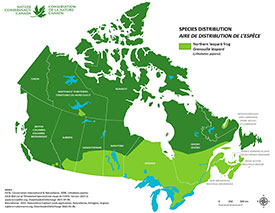
Northern leopard frog (Photo by Barb Houston)
Northern leopard frog
What does it look like?
The northern leopard frog measures five to 10 centimetres in length and is green or brown with dark spots surrounded by light halos. Females are typically bigger than males.
Where does it live?
The northern leopard frog ranges from southeastern BC to Labrador, and from southcentral Northwest Territories through central and southwestern United States. There are three Canadian populations: the eastern, western boreal/prairie and Rocky Mountain. The eastern population is found in Labrador, Nova Scotia, PEI, New Brunswick, Quebec and Ontario. Frogs occurring in Manitoba, Saskatchewan, Alberta and Northwest Territories are part of the western boreal/prairie population. The Rocky Mountain population is restricted to the southeastern corner of BC.
This amphibian can be found in one of three distinct habitats, depending on the season. During winter, it hibernates in well-oxygenated rivers, creeks, ponds and lakes that do not freeze to the bottom. During the breeding season, it occupies marshes, ponds and lakeshores, typically those with plenty of vegetation. It occasionally breeds in slow-moving creeks and streams. In summer, it often disperses into grasslands and forests.
What is this species’ conservation status?
Globally, the northern leopard frog has been assessed as least concern, but is declining throughout its range. In Canada, the western boreal/prairie population is designated as special concern, the eastern population is not at risk and the Rocky Mountain population is endangered.
What is NCC doing to protect habitat for this species?
Many NCC properties provide habitat for the northern leopard frog. It has been observed on Manitoba’s Riding Mountain House property, Saskatchewan’s Fairy Hill and Stark Coulee properties, Molde Complex, Wideview Complex and Missouri Coteau Natural Area, Ontario’s MacMillan Nature Reserve, as well as several properties in Nova Scotia, New Brunswick and PEI. In BC, NCC has worked to conserve the Frog Bear Conservation Corridor in the Creston Valley, which has the only known breeding spot for this species in BC.






